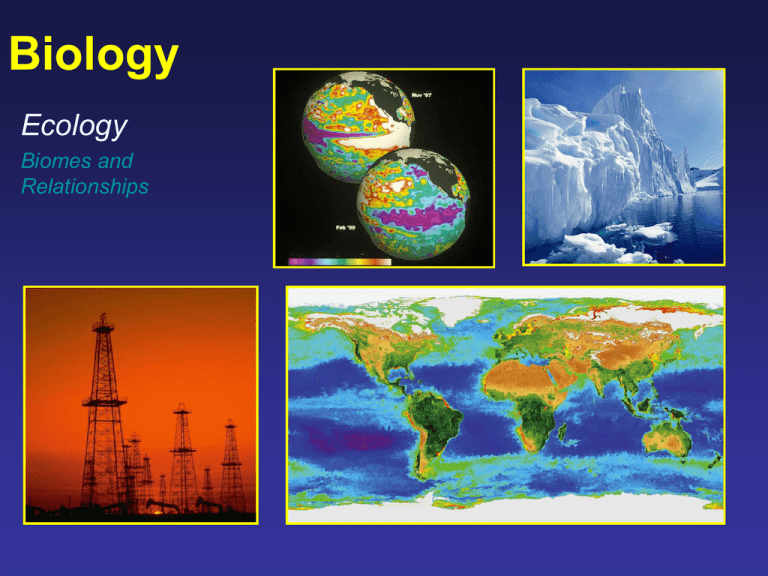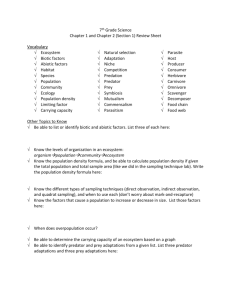Ecology 1
advertisement

Biology Ecology Biomes and Relationships What are the Characteristics of Life? Biotic – living components of an ecosystem Abiotic – Nonliving component of an ecosystem All things living have the following specific properties: •Cellular organization •Metabolism •Homeostasis •Respond to their Environment •Reproduction •Heredity Other animals 281,000 Fungi 69,000 Prokaryotes 4,800 Insects 751,000 Plants 248,400 Protists 57,700 Known species 1,412,000 About 1.4 million species have been identified, but estimates of number of species range from 3.6 million to 100 million Activity Ecosystem Organization Overview Biosphere- Zone of earth where life is found. Sometimes called the ecosphere Ecosystems- Community of different species interacting with one another and with the chemical and physical factors making up its nonliving environment Communities- Populations of all species living and interacting in an area at a particular time Populations- Group of individual organisms of the same species living in a particular area Organisms Any form of life (species)- group of organisms that resemble one another in appearance, behavior, chemical makeup and processes, and genetic structure. Ecosystem Components The major components of ecosystems are abiotic (nonliving) water, air, nutrients, solar energy, and biotic (living) plants, animals, and microbes. Niche – How organisms interact with each other within a community. An organism role in the ecosystem Habitat is the place where a population or an individual organism usually lives Climate Long-term average weather patterns 30-1 million years It is determined by Average Precipitation and Average Temperature Influence by Latitude Altitude Ocean Currents That affects Where organisms Live (Habitat) How Organisms Live (Niche) What organisms eat (energy flow) Temperature Controls Factors that influence ecosystem Major Biomes and the Role of Climate The amount of energy received and topography of a region determines climate. Terrestrial parts of the biosphere are classified as biomes, areas such as deserts, forests, and grasslands. Temperature, precipitation and topography (abiotic factors) determine the vegetation (plants) and the animals they will support Aquatic life zones describe the many different areas found in a water environment, such as freshwater or marine life zones (coral reefs, coastal estuaries, deep ocean). Biomes of the World Polar Temperate Tropic of Cancer Equator Tropics Tropic of Capricorn Arctic tundra (polar grasslands) Desert Boreal forest (taiga), evergreen coniferous forest (e.g., montane coniferous forest) Tropical rain forest, tropical evergreen forest Semidesert, arid grassland Mountains (complex zonation) Temperate deciduous forest Tropical deciduous forest Ice Temperate grassland Tropical scrub forest Dry woodlands and shrublands (chaparral) Tropical savanna, thorn forest Forests Tropical Rainforest Deciduous Forest Taiga Grassland Tundra Desert Unique Environments Mountains Ice Worlds Caves Aquatic Life Zones-Marine and freshwater portions of the biosphere. Examples include freshwater life zones (such as lakes and streams) and ocean or marine life zones Sun Sea level 50 Euphotic Zone 100 Estuarine Zone Continental shelf 200 500 Bathyal Zone 1,000 1,500 Marine Life Zones: Shallow seas Photosynthesis 0 Twilight Open Sea Depth in meters Abyssal Zone 2,000 3,000 Open Ocean 4,000 5,000 10,000 Darkness High tide Low tide Coastal Zone Freshwater Life Zones Freshwater life zones contain less than 1% by volume of salt. These zones include standing (lentic) bodies such as lakes, ponds, and wetlands and flowing (lotic) systems such as streams and rivers. Lentic bodies Standing water Lakes are large natural bodies of standing water found in depressions. Rainfall, melting snow, and stream drainage feed lakes. Lakes generally consist of four distinct zones depending on depth and distance from shore Major Characteristics of Freshwater Stream and Rivers The source zone is narrow and fast moving. It dissolves large amounts of oxygen from air and most plants are attached to rocks. Light is available, but is not very productive. Flowing Freshwater Systems Three aquatic life zones, each with different conditions can be identified along stream flow. The transition zone forms wider, deeper streams that flow down gentler slopes. The water is warmer, with more nutrients and supports more producers, but has slightly lower dissolved oxygen. The floodplain zone has wider, deeper rivers. Water temperature is warmer, less dissolved oxygen is present, and flow is slower. Freshwater Life Zones Wetlands Types: Marshes: dominated by grasses and reeds few trees Swamps: dominated by trees and shrubs Prairie Potholes: depressions carved out by glaciers Floodplain: which receive excess water during heavy rains and floods Tundra: receive excess water during the artic summer Seasonal: Are wetland are only soggy for a short time of the year Importance of wetlands Inland wetlands cover the land for a part of all of each year. Wetlands include swamps, marshes, prairie potholes, floodplains, and arctic tundra in summer. Scientists also use soil composition and plant life to define whether a particular area is a wetland. Wetlands provide a number of free ecological services such as filtering toxic wastes/pollutants, absorbing/storing excess water from storms, and providing habitats for a variety of species. Relationships Predator / Prey Symbiotic Relationships A relationship in which two species live closely together Mutualism Commensalism Parasitism Symbiotic Species Interactions: Mutualism (+/+) Pollination mutualism Insects Nutritional mutualism Hermit crabs and Anemones Gut inhabitant mutualism Cellulose digesting protozoa Parasitism (+/-) Parasite – organisms feeding on or in another species Host – organisms fed on by parasites External parasites Internal parasites Commensalism (+/0) Species interaction that benefits one and has little or no effect on the other. Example: Small plants growing in shade of larger plants or Hermit crab and Rag worm Lifecycle of a Parasite The head of the tapeworm is called a scolex, and is equipped with hooks and suckers which are used for attaching to the intestinal wall of the host. Adult tapeworms, some reaching a length of 15 feet, are parasites in the guts of animals and absorb nutrients across their body surface. The structures behind the head are called proglottids. Species Interactions – Predation / prey Prey Acquisition Example: Killer Whales Predator Avoidance Camouflage Span worm Deceptive Behavior Wandering leaf insect Deceptive Look Chemical Warfare Predator / prey relationships – Tundra Savannah Ocean Hind wings of Io moth resemble eyes of a much larger animal Poison dart frog Mimicry Bombardier beetle Hunting and Escaping When touched, the snake caterpillar changes shape to look like the head of a snake Foul-tasting monarch Butterfly Viceroy butterfly mimics monarch butterfly Predator Avoidance - Camouflage American Bittern (Botaurus lentiginosus) camouflaged, Florida. Flatfish on sand, showing ability to blend with background. Protective coloration and camouflage. Crab Spider camouflaged on a Woodland Sunflower. Predator Avoidance Mimics Ant Mimic Spider (Castianeira variata) with ant. Moth (Eupterotidae) mimicking a chewed leaf. Viceroy (top) and Monarch (below) Butterflies. Mullerian mimicry. Predator Avoidance Chemical Warfare and Warning Coloration Three-Striped Poison Frog (Epipedobates trivittatus), Tambopata River, Peru. Monarch caterpillar (Danas plexippus) on Milkweed. Eastern Coral Snake (Micrurus fulvius), Florida. Ecology – Key Terms • • • • • • • • • • • • • • • • Ecology Abiotic Biotic Population Community Ecosystem Habitat Niche Predator Prey Symbiosis Commensalism Parasitism Mutualism Organism Biosphere Organizing key terms: Living v. nonliving Organization Relationships Biotic (living) Biosphere Symbiosis: Mutualism (+/+) Commensalism (+/0) Parasitism (+/-) Abiotic (nonliving) Ecosystem Community Predator Prey Population Organism (species) Habitat (location) Niche (role / job)








